Inverse b Processes and Nonconservation
advertisement
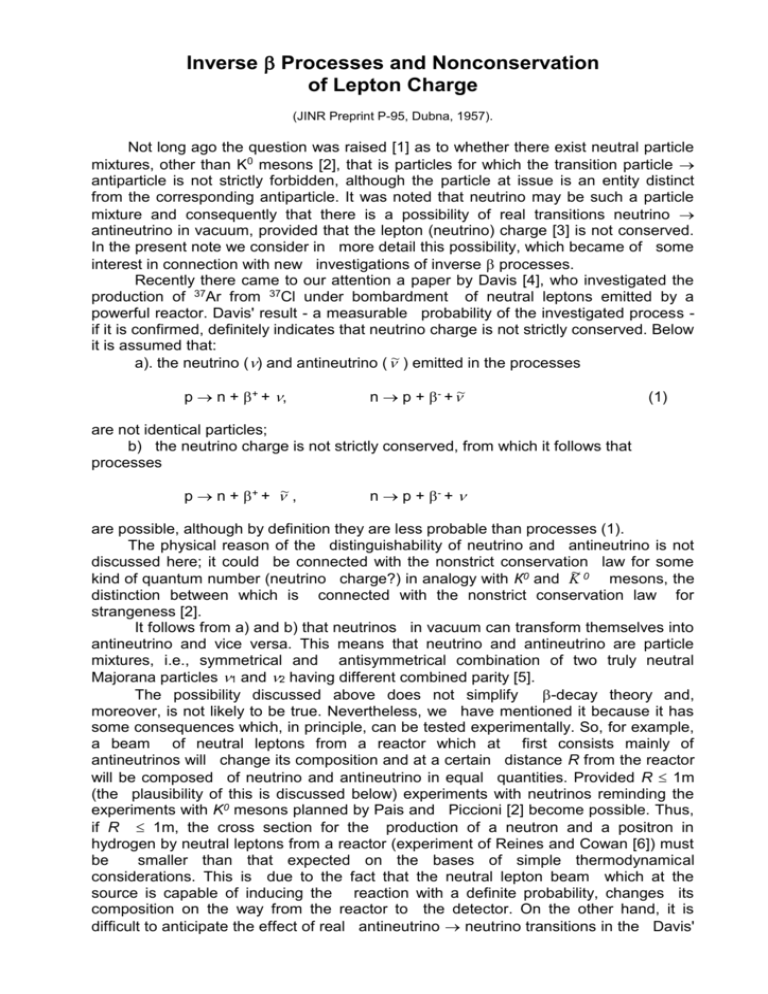
Inverse Processes and Nonconservation of Lepton Charge (JINR Preprint P-95, Dubna, 1957). Not long ago the question was raised [1] as to whether there exist neutral particle mixtures, other than K0 mesons [2], that is particles for which the transition particle antiparticle is not strictly forbidden, although the particle at issue is an entity distinct from the corresponding antiparticle. It was noted that neutrino may be such a particle mixture and consequently that there is a possibility of real transitions neutrino antineutrino in vacuum, provided that the lepton (neutrino) charge [3] is not conserved. In the present note we consider in more detail this possibility, which became of some interest in connection with new investigations of inverse processes. Recently there came to our attention a paper by Davis [4], who investigated the production of 37Ar from 37Cl under bombardment of neutral leptons emitted by a powerful reactor. Davis' result - a measurable probability of the investigated process if it is confirmed, definitely indicates that neutrino charge is not strictly conserved. Below it is assumed that: a). the neutrino () and antineutrino ( ~ ) emitted in the processes p n + + + , n p + - + ~ (1) are not identical particles; b) the neutrino charge is not strictly conserved, from which it follows that processes p n + + + ~ , n p + - + are possible, although by definition they are less probable than processes (1). The physical reason of the distinguishability of neutrino and antineutrino is not discussed here; it could be connected with the nonstrict conservation law for some ~ 0 mesons, the kind of quantum number (neutrino charge?) in analogy with К0 and K distinction between which is connected with the nonstrict conservation law for strangeness [2]. It follows from a) and b) that neutrinos in vacuum can transform themselves into antineutrino and vice versa. This means that neutrino and antineutrino are particle mixtures, i.e., symmetrical and antisymmetrical combination of two truly neutral Majorana particles 1 and 2 having different combined parity [5]. The possibility discussed above does not simplify -decay theory and, moreover, is not likely to be true. Nevertheless, we have mentioned it because it has some consequences which, in principle, can be tested experimentally. So, for example, a beam of neutral leptons from a reactor which at first consists mainly of antineutrinos will change its composition and at a certain distance R from the reactor will be composed of neutrino and antineutrino in equal quantities. Provided R 1m (the plausibility of this is discussed below) experiments with neutrinos reminding the experiments with K0 mesons planned by Pais and Piccioni [2] become possible. Thus, if R 1m, the cross section for the production of a neutron and a positron in hydrogen by neutral leptons from a reactor (experiment of Reines and Cowan [6]) must be smaller than that expected on the bases of simple thermodynamical considerations. This is due to the fact that the neutral lepton beam which at the source is capable of inducing the reaction with a definite probability, changes its composition on the way from the reactor to the detector. On the other hand, it is difficult to anticipate the effect of real antineutrino neutrino transitions in the Davis' experiment [4], since in this case one deals with a nonstrictly inverse process, and there may be such unknown factors as the polarization and the energy dependence of the polarization of neutral leptons from the reactor as well as from the decay 37Ar 37Cl. Consequently it is impossible to conclude a priori - as it would be in the case of parity conservation - that the antineutrino beam, which at first is essentially uncapable of inducing the reaction in question, transforms itself into a beam in which a definite fraction of particles can induce such reaction. However, it cannot be excluded that the aparent contradiction between the small probability of double decay processes [7] and the relatively high probability of 37Ar production in Davis' experiment [4] is partly connected with a change in the composition of the neutral lepton beam on the way from the reactor to the detector in the last experiment. The upper limit of R which can give observable effects in the experiment of Cowan and Reines [6] is of the order of a meter, which corresponds to a time for the transformation neutrino antineutrino T 10-8 sec. If one takes into account that the neutrino energy - as pointed out by I. Pomeranchuk - is always larger by several orders of magnitude than mc2 (m is the neutrino rest mass) and that, consequently, in the laboratory system there is a considerable relativistic increase of the transformation time, then the question arises as to whether the condition T 10-8 sec is plausible at all even if assumptions a) and b) are true. The time T is connected with the mass difference m of particles 1 and 2, m is proportional to the first power of the matrix element H of the transition ~ , about which, unfortunately, it is impossible to say anything definite, unless a more concrete assumption on decay processes is done: for example, Preston [8], assumed that the scalar term in the interaction is responsible for neutrino emission; and the tensor term, for antineutrino emission, the corresponding coupling constants being different but of comparable values. In such a case the ~ transformation is due to two virtual transitions, everyone of which is characterized by a coupling constant of the same order as the constant G of all weak interaction (G~10-7-10-6 in units h = с = µ = 1, where µ is the pion mass). Consequently, H will be proportional to G2, and m turn out to be about 10-11eV. The time T is neutrino. energy [9] about 10-10· sec, which is considerably greather than 10-8sec. m c 2 Nevertheless, there might exist a direct interaction (of the first order in G) responsible for the neutrino antineutrino transformation ~ ) ~ ( ~ N N In this case m is proportional to the first power of the coupling constant [9] and T neutrino. energy turnes out to be about 10-16 sec. For neutrino energies 1 MeV and m c 2 taking m = 100eV (experiments [10] indicate that the neutrino mass is less than 500eV), we get T~10-12sec. In conclusion it is interesting to underline that, independently of the plausibility of the concrete effects which were discussed above, nonconservation of neutrino charge under the condition that neutrino and antineutrino are distinguishable entities (or, which is the same, the existence of two Majorana neutrinos with different combined particles) inevitably leads to effects of the Gell-Mann-Pais-Piccioni type [2]. Under the above assumptions, effects of transformation of neutrino into antineutrino and vice versa may be unobservable in the laboratory because of large values of R, but will certainly occur, at least, on an astronomic scale. The author is grateful to I. Pomeranchuk and L. Okun for interesting discussions. Joint Institute for Nuclear Research REFERENCES 1. Pontecorvo B. // ZhETF, 1957, vol.33,p.549. 2. Gell-Mann M, Pais A. // Phys. Rev., 1955, vol.97, p.1387; Pais A., Piccioni O. // Phys. Rev., 1955,vol.100, p.1487. 3. Zeidovich Ya. // Dokl. Akad. Nauk SSSR, 1952, vol.86, p.505. 4. Davis R. An Attempt to Observe the Capture of Reactor Neutrinos in Clorine-37, in print. 5. Landau L. // ZhETF, 1957, vol.32, p.405. 6. Reines F., Cowan C. // Science, 1956,vol.124, p.100. 7. Awschalom M. // Phys. Rev., 1956,vol.101, p.1041; Dobrochotov E., Lazarenko V., Lukianov S. // Dokl. Akad. Nauk. SSSR, 1956, vol.110, p.966. 8. Preston M. // Quoted in 4, in print, GB. 9. Okun L., Pontecorvo B. // ZhETF, 1957,vol.32, p.1957. 10. Hanna G., Pontecorvo В. // Phys. Rev., 1949. vol.75, p.983; Curran S., Angus J., Cockroft A. // Phys. Rev., 1949, vol.76, p.853; Longer L, Moffat R. // Phys. Rev., 1952, vol.88, p.689; Hamilton D., Alford W., Cross L. // Phys. Rev., 1953, vol.92, p. 1521.


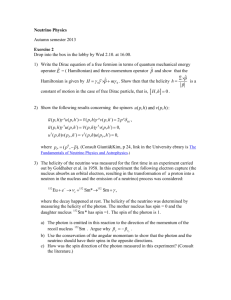
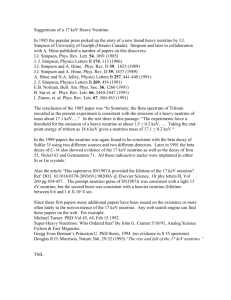


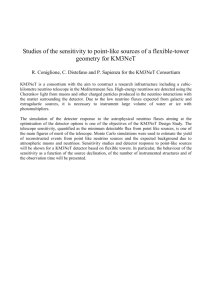


![Improved Search for [subscript ] [subscript e] Please share](http://s2.studylib.net/store/data/012105937_1-590ef4750648c217183c040af2ab4d5b-300x300.png)
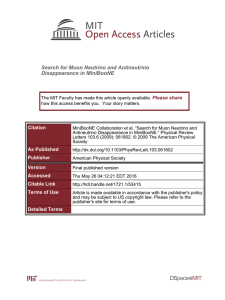
![Dual baseline search for muon antineutrino disappearance at 0.1eV[superscript 2]<m[superscript 2]<100eV[superscript 2]](http://s2.studylib.net/store/data/012105430_1-70bc54917f1462ef44c8a8a0468cf797-300x300.png)